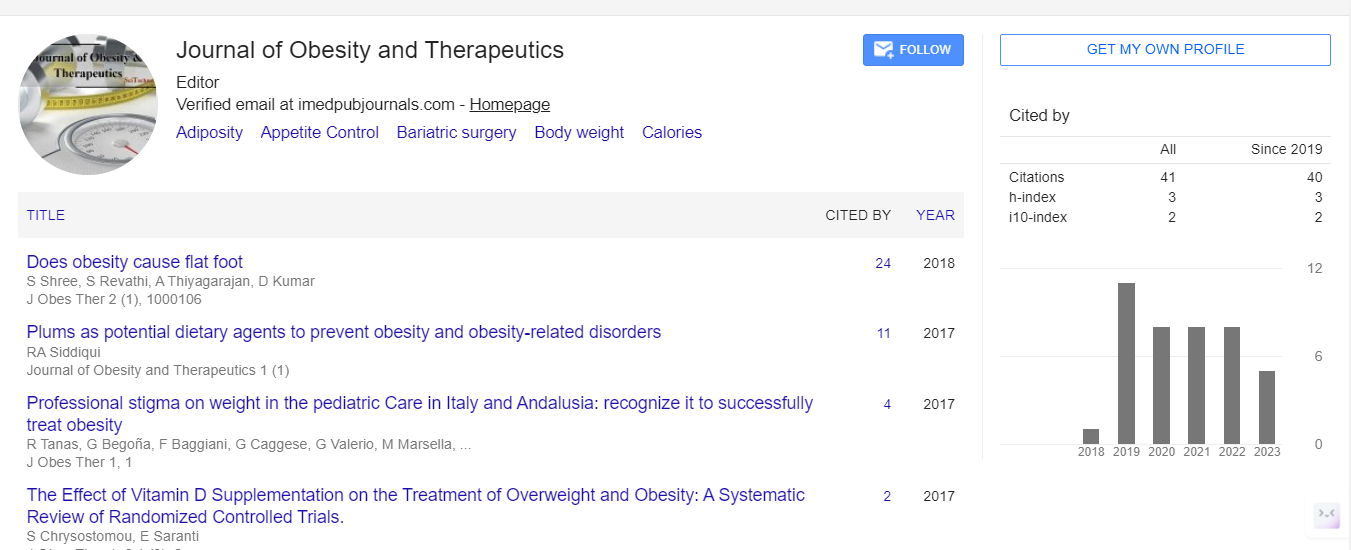Short Communication, J Obes Ther Vol: 7 Issue: 1
Abdominal Fat and Waist Circumference in Type 2 Diabetes
Liam Euncheol*
Department of Endocrinology and Metabolism, Tianjin Medical University, Tianjin, China
*Corresponding Author: Liam Euncheol
Department of Endocrinology and
Metabolism, Tianjin Medical University, Tianjin, China
E-mail: liameuncheol@tmu.edu.cn
Received date: 20 February, 2023, Manuscript No. JOT-23-93703;
Editor assigned date: 22 February, 2023, PreQC No JOT-23-93703 (PQ);
Reviewed date: 09 March, 2023, QC No JOT-23-93703;
Revised date: 16 March, 2023, Manuscript No. JOT-23-93703 (R);
Published date: 23 March, 2023, DOI: 10.4172/jot.1000230
Citation: Ogunka-Nnoka CU, Ben-Piakor TE, Mepba HD, Ifeanacho MO (2020) Effect of Processing on Phytochemicals and Nutrient Composition of Tiger Nut (Cyperus esculentus L). J Food Nutr Disor 9:2. doi: 10.37532/jfnd.2020.9(2).271
Description
Type 2 Diabetes (T2D) is a chronic metabolic disorder characterized by elevated blood glucose levels due to insulin resistance and impaired insulin secretion [1,2]. T2D is associated with several comorbidities such as cardiovascular disease, hypertension, dyslipidemia, and obesity. The increasing prevalence of T2D worldwide is a major public health concern, with obesity being a significant risk factor for T2D. Among the different measures of obesity, abdominal fat and waist circumference have been found to be strongly associated with T2D risk [3,4]. Abdominal fat, also known as visceral fat, is located deep within the abdomen and surrounds vital organs such as the liver, pancreas, and intestines. Compared to subcutaneous fat, which is located just beneath the skin, abdominal fat is more metabolically active and releases several bioactive molecules that can cause insulin resistance and inflammation [5]. Abdominal fat has been found to be a stronger predictor of T2D risk than overall body fat, with studies suggesting that even lean individuals with excess abdominal fat are at increased risk of T2D. Waist circumference is a simple and practical measure of abdominal fat and has been shown to be strongly associated with T2D risk [6,7]. The International Diabetes Federation (IDF) defines abdominal obesity as a waist circumference of ≥ 94 cm in men and ≥ 80 cm in women. The American Heart Association (AHA) and the National Heart, Lung, and Blood Institute (NHLBI) define abdominal obesity as a waist circumference of ≥ 102 cm in men and ≥ 88 cm in women [8]. Several studies have shown that individuals with larger waist circumferences are at increased risk of T2D, even after controlling for overall body fat.
Abdominal fat and waist circumference have been linked to T2D through several mechanisms. First, abdominal fat releases Free Fatty Acids (FFAs) into the bloodstream, which can cause insulin resistance in peripheral tissues such as muscle and liver [9,10]. Second, abdominal fat releases adipokines such as adiponectin and leptin, which can modulate insulin sensitivity and glucose metabolism. Third, abdominal fat can lead to chronic inflammation through the secretion of pro-inflammatory cytokines such as Tumor Necrosis Factor-Alpha (TNF-α) and Interleukin-6 (IL-6), which can impair insulin signaling and promote T2D development. Finally, abdominal fat can cause dysfunction of beta cells in the pancreas, leading to impaired insulin secretion and T2D [11]. Given the strong link between abdominal fat, waist circumference, and T2D, measuring waist circumference can be a useful tool for identifying individuals at increased risk of T2D. The IDF and AHA or NHLBI recommend measuring waist circumference as part of routine health checks, along with other measures such as Body Mass Index (BMI) and blood glucose levels. Lifestyle interventions such as diet and exercise can be effective in reducing abdominal fat and improving insulin sensitivity, thereby reducing T2D risk.
Conclusion
Abdominal fat and waist circumference are important measures of obesity that are strongly associated with T2D risk. Abdominal fat releases several bioactive molecules that can cause insulin resistance, inflammation, and impaired insulin secretion, leading to T2D. In addition, pharmacological interventions such as metformin and thiazolidinedione’s have been found to be effective in reducing T2D risk in individuals with impaired glucose tolerance and insulin resistance.
References
- Kay SJ, Fiatarone Singh MA (2006) The influence of physical activity on abdominal fat: a systematic review of the literature. Obes Rev 7(2):183-200.
- Björntorp P (1992) Abdominal fat distribution and disease: an overview of epidemiological data. Ann Med 24(1):15-8.
- Borkan GA, Gerzof SG, Robbins AH, Hults DE, Silbert CK et al (1982) Assessment of abdominal fat content by computed tomography. Am J Clin Nutr 36(1):172-7.
- Miller KD, Jones E, Yanovski JA, Shankar R, Feuerstein I et al (1998) Visceral abdominal-fat accumulation associated with use of indinavir. Lancet 351(9106):871-5.
- Seidell JC, Oosterlee A, Thijssen MA, Burema J, Deurenberg P et al (1987) Assessment of intra-abdominal and subcutaneous abdominal fat: relation between anthropometry and computed tomography. Am J Clin Nutr 45(1):7-13.
- DeFronzo RA, Ferrannini E, Groop L, Henry RR, Herman WH et al (2015) Type 2 diabetes mellitus. Nat Rev Dis Primers 1(1):1-22.
- Olokoba AB, Obateru OA, Olokoba LB (2012) Type 2 diabetes mellitus: a review of current trends. Oman Med J 27(4):269.
- Leahy JL (2005) Pathogenesis of type 2 diabetes mellitus. Arch Med Res 36(3):197-209.
- Dabelea D, Mayer-Davis EJ, Saydah S, Imperatore G, Linder BP et al (2014) revalence of type 1 and type 2 diabetes among children and adolescents from 2001 to 2009. JAMA 311(17):1778-86.
- Staiger H, Machicao F, Fritsche A, Häring HU (2009) Pathomechanisms of type 2 diabetes genes. Endocr Rev 30(6):557-85.
- Nihiser AJ, Lee SM, Wechsler H, McKenna M, Odom E et al (2007) Body mass index measurement in schools. J Sch Health 77(10):651-71.
 Spanish
Spanish  Chinese
Chinese  Russian
Russian  German
German  French
French  Japanese
Japanese  Portuguese
Portuguese  Hindi
Hindi 